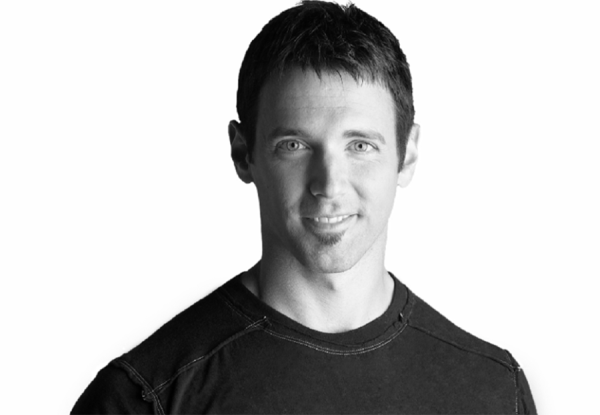This is part 2 in an exclusive interview with Dr. John Berardi about “Energy Flux” – also known as “G-Flux”, which refers to the amount of energy flowing into and out of a system – namely, calories in and out of your body! This advice that can be gleaned from the G-flux concept could be neatly summarized as “Eat More – Exercise More.” In parts 1 & 2, we weighed in the evidence suggesting that it may be far more effecient for burning fat and building muscle to eat more and exercise more than the reverse (starving yourself, while not exercising or exercising very little). That leads us to the final “burning” question: Exactly how much exercise are we talking about here?…

The G-Flux Interview With John Berardi And Tom Venuto: A Burn the Fat Blog Archives Classic. Originally published March 26th, 2007.
Tom Venuto: If you’re eating more and training more, obviously this allows you a higher intake of amino acids, essential fatty acids, fiber, vitamins, minerals and phytonutrients. Is this an important benefit of the higher G-flux approach or can nutritional supplements make up for lower intakes of these nutrients at low energy intakes? And on the flip side, if you’re taking in copious amounts and a wide variety of whole foods, which high energy intake allows you to do, are many supplements really necessary?
John Berardi: You got it, Tom. I believe that the high intake of vitamins, minerals, phytonutrients, fiber, etc. is one of the greatest and most overlooked advantages of the G-Flux approach. Higher intakes of these nutrients (when accompanied by a high G-Flux) can lead to better health, better nutrient partitioning, lower disease risk and more. So you end up with more exercise (which leads to a better health profile and less body fat) and more high quality nutrition (which also leads to a better health profile and better body composition). You can’t go wrong there.
Specific to your question, assuming one decides to follow a low-flux lifestyle; nutritional supplements may become important. Low exercise volume means less food eaten (assuming you want to stay lean and healthy). And less food eaten means fewer nutrients. With the vitamin and mineral contents of our fruits and veggies somewhat lower than they have been in the past, each serving of fruit and veggie contains less of the important, health-promoting nutrients.
Therefore we either have to eat more of them or we have to supplement with multi-vitamin/multi-mineral formulas and greens food products (for our phytochemicals). In fact, both the Journal of the American Medical Association and the British Medical Journal have recommended daily multi-vitamin supplements for this reason.
Often times, competitive bodybuilders have to move toward a lower flux lifestyle in an attempt to get very lean for the competitive stage. While their exercise volume remains quite high, their calorie intake can go quite low. This is because they need to achieve extreme levels of muscularity and low body fat. As a result, in each of these athletes, I’m very conscious of supplementing with a multi-vitamin and mineral as well as a green food product. I’m also sure to recommend fish oil supplements. This helps these athletes get their essential nutrients while keeping their calories very low for short periods of time.
However, on the flip side, if an athlete of mine is exercising with fairly high volumes and eating their recommended 10-15 servings of fruits and veggies each day, their need for multi-vitamin/multimineral supplements is reduced. In fact, a number of my more disciplined Olympic and Pro athletes take no additional vitamins/minerals beyond what they get in their whole foods. And I prefer it this way as the vitamins, minerals, and phytonutrients present in whole foods are often better than commercially available supplements.
Tom Venuto: You often talk about “tissue turnover” and in your Charles Staley interview, I found your comments about everyone having a “second chance” to be both interesting and encouraging, especially for people starting later in life and those who have had an unhealthy lifestyle for many years. Could you explain a little bit about tissue turnover and the significance to body composition and also to ones health?
John Berardi: Regular exercise, especially strength training, creates muscle damage which, in turn, leads to the rebuilding of muscle proteins and overall muscle remodeling. This regular program of weight training induced tissue breakdown followed by tissue rebuilding is called “tissue turnover.”
Just like your skin cells will die and be sloughed off with regularity, only to be replaced by new skin cells, every cell of the body goes through the same process, albeit at different rates. Your bone cells, muscle cells, brain cells, and more are constantly “turning over.”
Interestingly, if rates of muscle tissue turnover are accelerated, we have the ability of more quickly improving our body composition. By keeping turnover rates high in the muscle, we have a better ability to destroy old and weaker muscle and replace it with new and stronger muscle, muscle better adapted to our training. Yet higher turnover also leads to a higher metabolic rate. And this means less body fat.
So, in the end, the harder and more frequently we train, the more remodeling we’ll see. Further, by keeping our calories and protein intake high, we can force more rapid tissue turnover. And this results in better muscle quality as well as a faster metabolic rate.
Tom Venuto: Would you say that it’s easier to gain lean body mass at a higher level of energy flux? How do you balance high energy flux with the belief most people have that more activity and especially aerobic work is counterproductive on muscle gain programs? You hear that sentiment a lot in the “hard gainer” or “skinny guy” types of weight gain programs and you also hear in scientific circles that high volume cardio and strength training do not mix. Obviously, you can still have a surplus at any level of activity as long as the food intake is high enough, but how much exercise is too much when muscle growth is the goal?
John Berardi: This is another one of those “it depends” questions. And it pretty much depends on body type. I believe that most body types can benefit from a higher level of G-Flux, to a point. For example, the typical endomorph needs a lot more exercise than the typical ectomorph for each goal set – fat loss, muscle gain, or maintenance. So the body comp conscious ectomorph should never be exercising as much as the body comp conscious endomorph.
Yet I’ve found that many ectomorphs benefit from a higher exercise volume than most recommend or than they’re naturally included to do. This, however, assumes that they have the wherewithal to keep scaling energy intake up until weight is gained. If they do (which, quite frankly, many of them don’t), they are more likely to gain a higher lean mass: fat mass ratio. In other words, they gain more muscle for every pound of fat they gain when “bulking up.” But it’s imperative that they match their additional exercise volume with a high food intake. If they don’t, of course, they will have a hard time gaining mass.
With respect to the idea that high volume strength work and cardio don’t mix, this is only the case if the cardio work is done at intensities necessary for endurance performance increases. We’re talking heart rates of 85% of max for durations of 45+ minutes and quite frankly, there are very few weightlifters who can sustain cardio at this intensity. So this is a non-issue.
In the end, I believe that body comp, including lean mass, can substantially be improved with intelligent increases in G-Flux. This is due to the fact that increased G-Flux improves carb tolerance, nutrient partitioning, and nutrient intake. Of course, if you’re someone with a naturally fast metabolism and have a heck of a hard time gaining lean mass, make sure you’re not overdoing it with the exercise volume.
In the Precision Nutrition Individualization Guide I discuss each body type and the recommended energy intakes and expenditures for each.
Tom Venuto: So if we’re going to increase energy flux that means more training, but what about overtraining? Is overtraining as much of a problem as the fitness and bodybuilding media make it out to be? Someone once said that there is no such thing as overtraining, only under nutrition. Is there any truth there or is that statement going too far?
John Berardi: Overtraining is a very real phenomenon although I guarantee that most people reading this have never been over trained. Heck, I bet they’ve never even met someone who’s been legitimately over trained. The only athletes I’ve ever seen over trained have been high level Olympians who train in excess of 20 hours per week for years at a time.
You see, overtraining is a real syndrome characterized by a host of psychological and physiological symptoms. And this syndrome is one that takes months of high volume training to develop. Further, once legitimately over trained, it can take 8-12 months to recover from.
Now that this is cleared up, we can discuss what most people think of as over training – central nervous system fatigue. CNS fatigue manifests in some of the same ways as over training although it can be developed over a much shorter period of time and is fairly easy to recover from with a planned break.
To this end, CNS fatigue can very well become an issue with high levels of G-Flux if someone isn’t careful to diversify their exercise profile. Trying to accomplish a high level of G-Flux with all high-intensity exercise is a recipe for CNS fatigue.
However, when some low intensity work is thrown into the mix, CNS recovery is much improved. This is because high intensity work stimulates the sympathetic nervous system (figure or flight) while low intensity work stimulates the parasympathetic nervous system (rest and digest). The balance between these two types of exercise is important, as originally proposed by Hans Selye in the 50s. It’s sort of a yin and yang thing.
So, although overtraining isn’t likely for the recreationally active, CNS fatigue can manifest if a proper balance of high and low intensity exercise isn’t achieved.
Tom Venuto: Even if someone agrees that overtraining is not as big a deal as some people make it out to be, we definitely have to agree that recovery is very important, so what are some of your best tips for improving recovery when training at a high volume?
John Berardi: As discussed above, I’m a big believer in balancing high intensity with low intensity work in the recreational exerciser. To this end, I believe some low intensity cardio should be done in conjunction with resistance training and interval work. This low intensity cardio, in and of itself, can help with recovery.
Also, I believe that sleep duration and quality can help with recovery. 7-9 hours of sleep per day seems to be the magic number.
Further, I believe that recovery can be accelerated with the right nutritional plan. This includes adequate amounts of fruits and veggies, essential fats, amino acids, vitamins, minerals, and phytochemicals.
Tom Venuto: What about periodization? Even for the non-athlete, shouldn’t training volume go higher at some times and lower at other times?
John Berardi: Absolutely. In fact, I forgot to mention one important thing in my last response; regular program variation and targeted back-off weeks.
I’m a huge proponent of training in 4-8 week blocks and, at the end of each block, switching the program up. During these training blocks, sets and reps may change slightly but the most important variable to cycle is training effort.
I think that both adaptation and recovery are best if training effort is less than 100% during the first week of a new program, close to 100% during the second week, a full 100% during the third week, and a full 100% during the fourth week. Then, during the fifth week, the program volume and intensity should be quite low. This would be considered a “back-off” week. Of course, nutritional intake would parallel this in that calories will be scaled back during the back-off training weeks.
There are many examples of how this works in practice but the point is the same – regular program variation is essential and back-off weeks necessary to prevent CNS fatigue and to continue making progress.
Tom Venuto: On the energy expenditure side of the equation, we typically think of strength training and cardio training, but you’ve also talked about the importance of training “multiple muscle qualities” and “loading parameters” and using GPP, high intensity interval training and traditional aerobic training. Sounds complicated. How does the average person balance all of this training? Or is this just your way of saying, “don’t spend hours on a treadmill… “cross train” and “get some variety in your workouts.”
John Berardi: As discussed above, it’s fairly simple. The message is this: make sure you’re doing some resistance training, some interval exercise (very high intensity reps interspersed with very low intensity reps), and some low intensity cardio.
Here’s what that might look like in practice:
Day 1 – Strength Exercise (60 minutes)
Day 2 – Interval Exercise (30 minutes) + Low Intensity Exercise (15 minutes)
Day 3 – Strength Exercise (60 minutes)
Day 4 – Interval Exercise (30 minutes) + Low Intensity Exercise (15 minutes)
Day 5 – Strength Exercise (60 minutes)
Day 6 – Interval Exercise (30 minutes) + Low Intensity Exercise (15 minutes)
Day 7 – Low Intensity Exercise (60 minutes)
Of course, based on your goals, your program might vary. The schedule above would be ideal for general body composition improvement as it involves some exercise every day and a healthy mix of high and low intensity work totaling 6 and ¼ hours of exercise per week.
Yet remember that not all of this exercise has to be done in the gym. Much of the interval work can be done outdoors and much of the lower intensity work can be done through play activities such as tennis, basketball, or going for a fast walk with your spouse, your kids, or your dog.
Tom Venuto: John, on one hand we have competitive athletes and bodybuilders, who are highly motivated and wouldn’t bat an eyelash at training 1 to 2 hours a day. In this group, I see the “whatever it takes” attitude, along with the physiques and performances that match it, I might add. But for the mainstream dieter, I have a feeling that “eat more, exercise more” is never going to be a popular approach and that only highly motivated individuals are going to embrace this concept. What are your thoughts?
John Berardi: As I mentioned in part one of this interview, we’re a sedentary society and there’s no getting around that. And, as I also mentioned, we’re built to move around a lot. Therefore we’re not doing what we were designed to do. And we’re paying the price.
So I don’t really have much of a message of hope for those who want short cuts or the easy way out. The best bodies are built on high levels of physical activity. That’s just the way it is.
Tom Venuto: So what should government health agencies recommend to the public (which includes the sedentary and obese), and what should fitness professionals recommend to their active, but non athlete clients? We could recommend a larger amount of exercise which we know will get our clients the best results, but on the other hand we run the risk of people dropping out or not even starting in the first place because it seems like too much work to be realistic. Do we scale back our recommendations with the idea that getting the public to do some exercise is a start and is better than no exercise? Or do we give a completely different set of guidelines to the public than we do to our more motivated and athletic clients?
John Berardi: The “scaled back” approach doesn’t work. The government already tried that with the whole 3x per week, 30 minute thing. And it failed miserably. So now they’ve gone the opposite direction. Current government guidelines are as follows:
For health improvement – 30 minutes of exercise every day
For weight management – 60 minutes of exercise every day
For weight loss – 90 minutes of exercise every day
Personally, I think this is a step in the right direction yet it still doesn’t clearly delineate what’s been shown to work. Studies at the University of Wyoming and the University of Pittsburgh have shown that the following are necessary for people to be happy with their bodies:
At least 5 hours of physical activity per week
At least 50% of the activity (2.5+ hours) coming from high intensity work
Interestingly, years of successful body transformations in the athletic and physique communities have also validated this information.
So there’s no big mystery. There’s research and years of examples demonstrating the efficacy of this approach. Therefore the recommendations are a no-brainer. I recommend the 5 hour, 50% thing as a starting point for those who are already recreationally active.
For beginners, a different approach may be necessary as 3x30min may be enough for them at the start. However after a few weeks they should be taught the necessity for exercise progression over time. This way, they’ll continue to see progress while working their way up to the 5 hour, 50% thing discussed above.
Tom Venuto: It’s pretty obvious that our society has a quick fix mentality. I’ve noticed now more than ever that the fitness industry seems to be pandering to this attitude by trying to come up with programs that get more done in less time. In one regard, I think this is great – up to a point – because it helps people avoid all or none thinking and it helps people like executives and busy moms stay fit. Unfortunately, I see this “less time – more results” attitude getting taken to ridiculous extremes with a never ending stream of “revolutionary” new workout programs based on “just minutes a day” and just a few days a week. What are your thoughts on the marketing of these super brief exercise programs and realistically, what can the average Joe expect from a minimal time commitment?
John Berardi: I’ll always laugh when I see these short programs (I think I saw a 4 minute and a 7 minute program recently) because they remind me of the 6 minute abs skit from the movie Something About Mary. Of course, I’m also laughing because I know they don’t work.
Sure, if the average Joe is a beginner, something is better than nothing. And this individual may see some small changes if they’re going from sedentary to 7 minutes. However, minimal time commitment eventually translates into minimal results.
Now, don’t get me wrong – I can respect someone who says: “I’m not willing to commit to more time so I’m OK with very small changes.” However, what drives me nuts is when folks expect huge returns on small investments. This is self-deception at its worst. Remember the 5 hour rule above. That’s the starting point for long-term health, body comp, and performance results.
Tom Venuto: Well, John, this has been very enlightening, thank you.
John Berardi: Thank you, Tom. It’s been great!
John Berardi is a prolific author, having published over 200 popular press articles for magazines like Men’s Health, Men’s Fitness, Women’s Health, Muscle and Fitness, Testosterone and more. Berardi has also authored or co-authored numerous books including Scrawny to Brawny, Metabolism Advantage and Gourmet Nutrition and is the creator of the Precision Nutrition System.
Copyright BurnTheFatBlog.com. No reproduction of this article permitted.






Leave A Comment